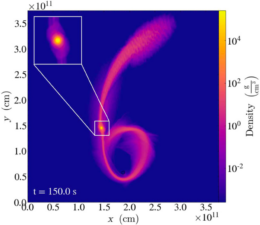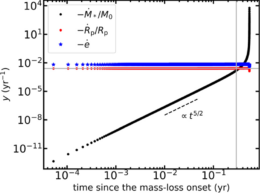Not everything astronomers observe has firmly supported explanations. Recently, however, advanced simulations have supported the hypothesis that certain flashes are the sign of a white dwarf in trouble.
Intermediate Mass, Extreme Danger
Intermediate mass black holes, though several thousand times smaller than their supermassive cousins, share many of the same egotistical personality traits. The more famous gargantuans tend to make themselves the center of attention by living in the middle of large galaxies and surrounding themselves with a dense core of stellar sycophants. Intermediate mass black holes similarly enjoy the spotlight, but on a smaller scale: they inhabit the centers of dwarf galaxies, or even smaller stellar clusters, but also surround themselves with many tightly-packed stars.
As a result of this dense environment, every now and then a star will get gravitationally bumped by its neighbors onto a trajectory that will carry it too close to the central black hole. Once within a certain distance, the star is doomed: as punishment for crossing an unseen barrier, the black hole will stretch the star into a long string of gas, which it will then consume. An even grislier fate awaits hardy white dwarf stars bumped onto very special trajectories that only graze this minimum distance. These stars will continue to circle the black hole on elongated, eccentric orbits, but each time they reach their closest distance, their outermost material will be peeled off and stripped away. Instead of destroying them quickly, the black hole will extend their suffering, slowly consuming them layer by layer, all the while burping out X-rays with each snack.
A Simulated Feast

A snapshot of a hydrodynamical simulation. The white dwarf core is shown in the inset; the long, spiraled streamer of gas represents material that has already been tidally stripped. [Chen et al. 2023]

The rate at which a white dwarf loses mass to the black hole. Over time, tidal stripping becomes more and more effective, until a certain point at which the white dwarf cannot maintain its structural integrity and is completely disrupted. [Chen et al. 2023]
Though the instruments needed to record such a signal are still several years away, these accurate simulations of white dwarf tidal stripping will help future astronomers make sense of the strange, somewhat frightening processes that make things flash in the night.
Citation
“Tidal Stripping of a White Dwarf by an Intermediate-mass Black Hole,” Jin-Hong Chen et al 2023 ApJ 947 32. doi:10.3847/1538-4357/acbfb6
